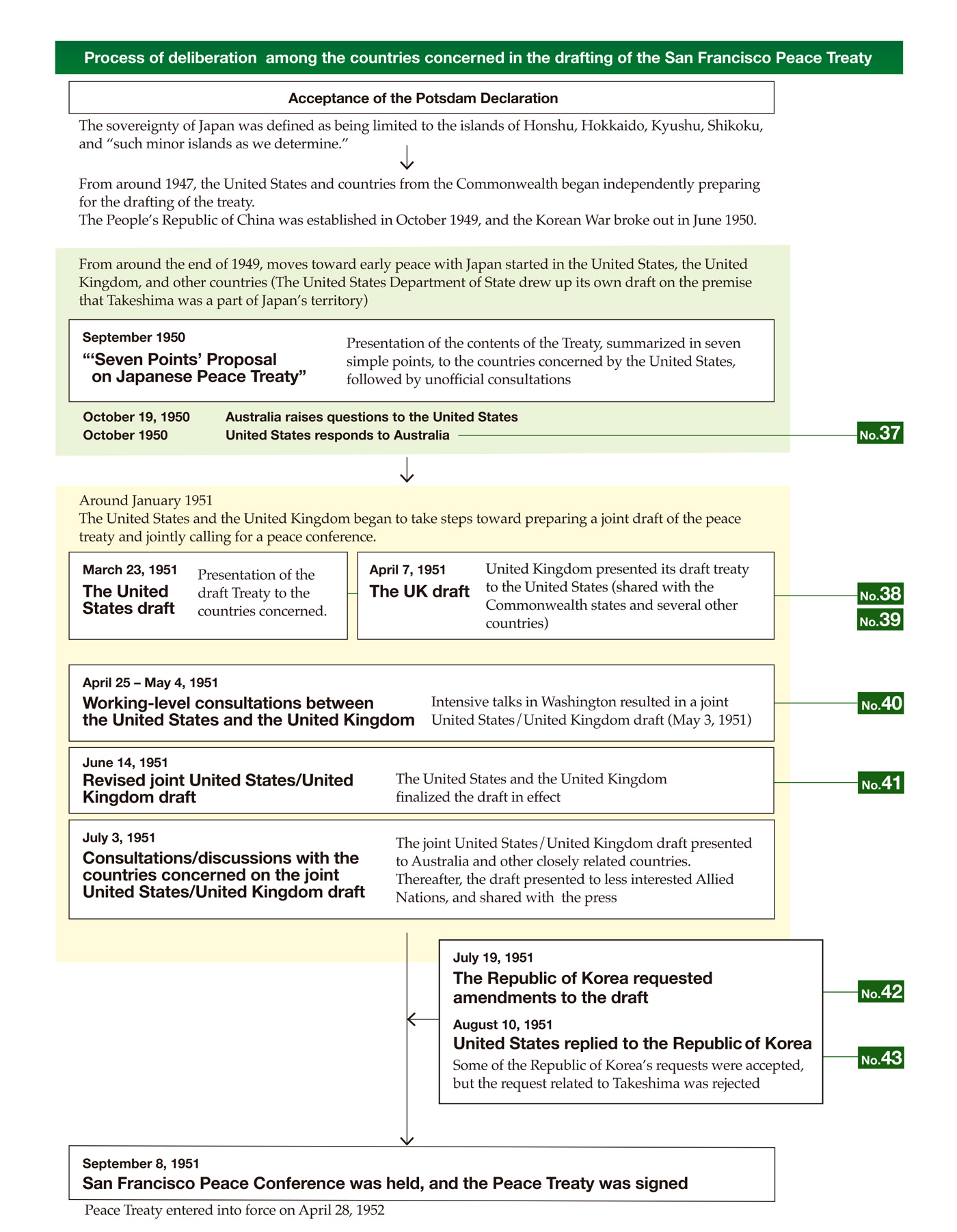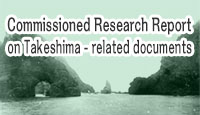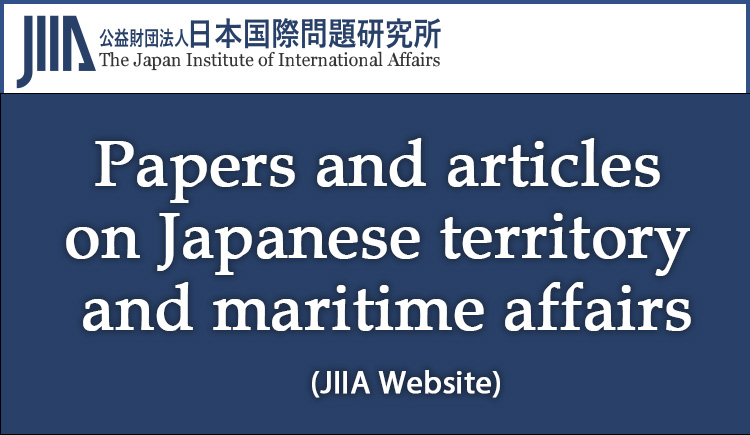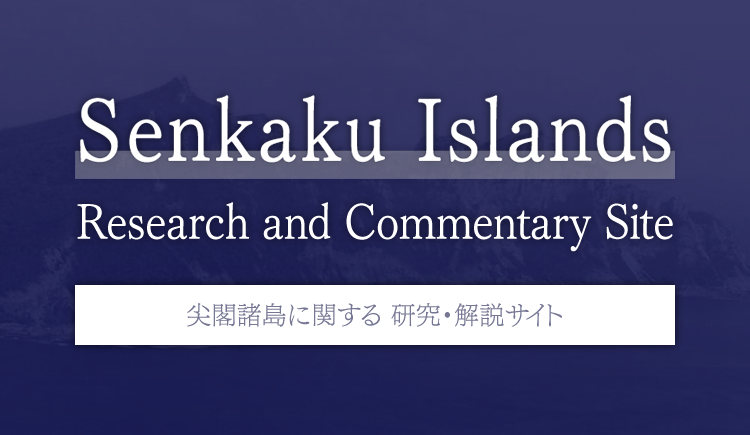The documents and materials published on this website were collected, researched, and prepared with advice from experts, as a part of a Government-commissioned project. The contents of this website do not reflect the views of the Government. Links to external sites (domains other than https://www.cas.go.jp) are not under the management of this site. For linked websites, please check with the organization/group that manages the website for the link in question.
Commentary on themes by historical period
Classification by historical periods III
Post WWII, before and after
the San Francisco Peace Treaty entered into force 1945-1952
(2) Details of the drafting of the San Francisco Peace Treaty
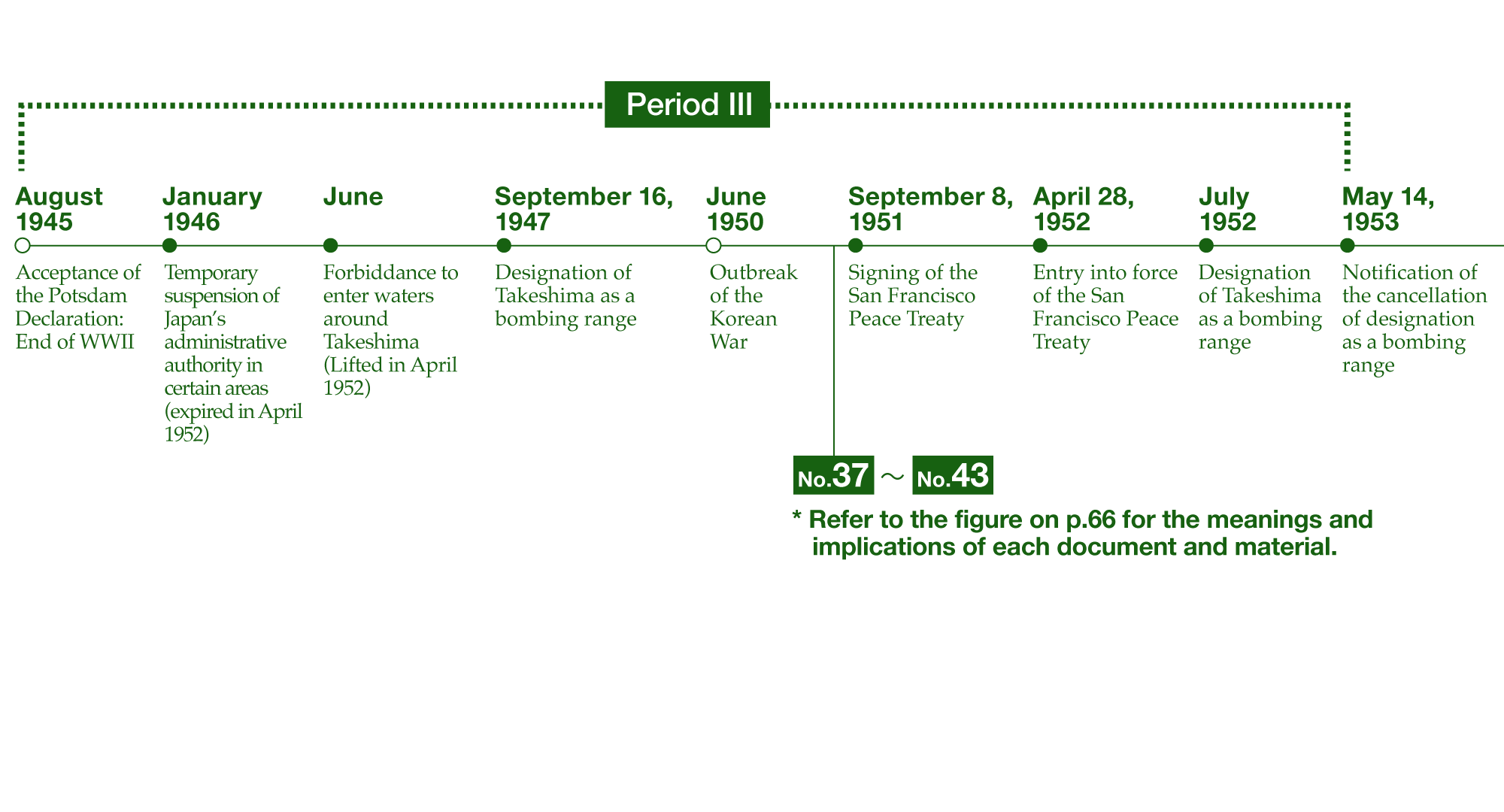
After World War II, the San Francisco Peace Treaty which brought the state of war between Japan and the Allied Nations to an end, stipulated that “Japan, recognizing the independence of Korea, renounces all right, title and claim to Korea, including the islands of Quelpart, Port Hamilton and Dagelet.” Examination of the details of the drafting history of this provision shows that Takeshima was intentionally excluded from the text.
It is known that in the process of drafting the San Francisco Peace Treaty, the Republic of Korea had
requested for Takeshima to be included within the regions that Japan would renounce its right toNo.42, However the United States had rejected that request
No.43based on its recognition of Takeshima as Japan’s territory. Diplomatic
documents disclosed by the United States before our research had already shown clearly that Takeshima
was not included in the “Korea” that Japan was renouncing its right to. In our document research project
since FY2016, while reconfirming the original sets of U.S. documents and materials that had been already
known, we have also collaborated with The Japan Institute of International Affairs since FY2018 to
conduct investigations in the United Kingdom and Australia, among others, and have gathered documents
and materials that shed light on how the United States coordinated opinions among the key countries
involved and drafted provisions that could be agreed upon as a consensus of the parties signing the
treaty.
As a result, we have confirmed once again that in drafting the San Francisco Peace Treaty, some Allied Nations, including the United Kingdom, Australia, and the Republic of Korea had great concerns about Chapter 2 (Territory), and that various opinions were exchanged in the process of coordination, and that the draft was revised multiple times. We have thus been able to clarify that the draft was finalized not solely from the perspective of the United States but was the result of a consultative process with these countries.
The following pages provide an explanation of the drafting process of the San Francisco Peace Treaty, and the meanings and implications of the documents and materials that were reconfirmed/found in our document research project.
サンフランシスコ平和条約
第二章(領域)
第二条
(a) 日本は朝鮮の独立を承認して、済州島、巨文島及び欝陵島を含む朝鮮に対するすべての権利、権原及び請求権を放棄する。
San Francisco Peace Treaty
Chapter II Territory
Article 2
(a) Japan recognizing the independence of Korea, renounces all right, title and claim to Korea, including the islands of Quelpart, Port Hamilton and Dagelet.
*The Japanese translation of the San Francisco Peace Treaty uses the characters “欝陵島” for Utsuryo Island, but the characters “鬱陵島” are used more commonly. In the main text of this report, the character “欝” is used only for excerpts of the articles, while the character “鬱” is used in other circumstances in principle.
1. Japan’s defeat in WWII, and acceptance of the Potsdam Declaration
In August of 1945, Japan accepted the Potsdam Declaration and surrendered to the Allied Nations. Article 8 of the Potsdam Declaration states “The terms of the Cairo Declaration shall be carried out and Japanese sovereignty shall be limited to the islands of Honshu, Hokkaido, Kyushu, Shikoku and such minor islands as we determine.” In other words, Japan’s territory apart from its four main islands were to be determined by “we” in the statement (the Declaration was signed by representatives of the United States, Republic of China, and the United Kingdom) (*1). This determination was made under the San Francisco Peace Treaty, which was the treaty that legally ended the state of war.
2. Details of the drafting of the San Francisco Peace Treaty
The work of drafting the Treaty commenced with preparations within the United States Department of State in 1947, and the coordination of views with other Allied Nations took place after 1947. After the end of the war, the situation in East Asia became increasingly fluid with the establishment of the People’s Republic of China in October 1949, and the growing momentum toward communism with the outbreak of the Korean War in June 1950. Amidst these developments, early reconciliation with Japan was discussed at a U.S.-UK Foreign Ministers’ Conference held in September 1949. In April 1950, former Senator Dulles, who had been appointed by President Truman as a consultant to the Secretary of State, commenced activities toward early reconciliation with Japan.
1. Draft prepared by the United States
In the first draft prepared by the U.S. Department of State in 1947, Takeshima was included as a part of the Korean territory to be renounced by Japan. However, upon gathering and analyzing relevant information, the U.S. Department of State included Takeshima in the islands constituting the territory of Japan in the draft they prepared at the end of 1949. Thereafter, the overall structure of the draft was reexamined in the summer of 1950. Instead of listing all the areas of Japan’s territory, the new version only stated the areas to be renounced by Japan. As a result, the text designating Takeshima as a part of Japan’s territory was removed.
2. Coordination of views between the United States and other countries
Before proceeding to treaty negotiations with the countries concerned, the United States
summarized and presented its basic stance in preparing the draft in the ““Seven Points” Proposal
on Japanese Peace Treaty”No.37, and sought the views
of the member countries of the Far Eastern Commission.
In October 1950, the Department of Foreign Affairs of Australia submitted written questions and
requested the United States to provide more detailed information about Japan’s territory. In
response, the United States answered that Japan would continue to retain Takeshima as a part of
its territoryNo.37, It was made clear
that the United States’ policy of considering Takeshima as a part of Japan’s territory remained
unchanged, even if provisions concerning the territories that Japan would retain had been
removed.
Based on the series of exchanges with the countries concerned, the United States considered that
it would be desirable to work in cooperation with the United Kingdom on peace with Japan. The
United States and the United Kingdom moved forward with consultations from around January 1951
with the intention of preparing a joint draft of the peace treaty, and jointly call conference of
peace with Japan.
The United States and the United Kingdom prepared their respective drafts for the joint draft.
The U.S. draft became ready for circulation in March 1951, and the UK draft in April of the same
year became ready and was shared with the United StatesNo.38. At this point, the
two countries had different
opinions about the approach to provisions relating to territory. The U.S. draft set out only the
territories that would be renounced by Japan, such as Korea and Taiwan, while the UK draft
encircled Japan within lines and posited that Japan’s sovereignty would continue over the islands
lying within these lines.
3. Anglo-American Meetings on Japanese Peace Treaty
A U.S.-UK working-level consultation was held from April 25 to May 4, 1951, and the both
countries agreed on many points and resulted in a joint draftNo.40. At this
consultation, the two countries concurred on provisions related to Japan’s renouncement of its
right to Korea, resulting in a compromise that reflected the intentions of both the United States
and the United Kingdom.
That is to say, at the 7th meeting held on May 2, the two countries concurred in adopting the
structure of the draft prepared by the United States in which not the areas that Japan retain its
sovereignty but those that Japan would renounce are explicitly provided for. The United Kingdom
asserted that the attribution of the islands lying between Japan and Korea should be clearly
stated, as any ambiguity about this point would cause future disputesNo.39. As a result, in the
hopes of preventing such disputes from occurring, the words “including the islands of Quelpart,
Port Hamilton and Dagelet” were added after the word "Korea" in the United States’ draft that had
originally only stated that Japan “renounces all right, title and claim to Korea”
No.40.
This coordination process was reflected in the joint United States/United Kingdom draft of May
3No.41. On June 14, a
joint United States/United Kingdom draft was drawn up through further consultations, being
finalized in substance.
4. Consultations with the countries concerned
The revised joint United States/United Kingdom draft was presented to the countries concerned for deliberation in July, 1951,and the provision in Article2(a) that Japan renounce its right, title and claim to Korea remained unchanged from the joint draft on Jun 14, 1951.
5. Request for amendment from the Republic of Korea
The joint United States/United Kingdom draft was also presented to the Republic of Korea. In July
1951, The Republic of
Korea sent a letter to the United States Secretary of State, requesting for amendments, including
one to the effect that Takeshima be placed under the ownership of KoreaNo.42.
In response to this amendment request, the United States issued a letterNo.43 rejecting Republic of
Korea’s request, due to it’s recognition of Takeshima as a part of Japan’s territory.
(*2)
3. San Francisco Peace Treaty as the grounds for Japan’s claim over ownership of Takeshima
In light of the abovementioned drafting process of the treaty, it is crystal clear that the authors of the treaty drafted Article 2 (a) that Japan renounce its right to “Korea, including the islands of Quelpart, Port Hamilton and Dagelet,” with the recognition that Takeshima belongs to Japan (*3).
*1 The Soviet Union also joined in the Potsdam Declaration when it participated in
the war against Japan. The instrument of surrender stipulating that Japan will “carry out the
provisions of the Potsdam Declaration in good faith,” was also signed by representatives of Australia,
Canada, the Netherlands, and New Zealand.
*2 Among the requests made by the Republic of Korea, except that on Takeshima, there
were requests that were accepted, resulting in amendments to the draft (amendment to Article 4(a), and
insertion of (b)). In short, the Republic of Korea was given the opportunity to present its views in
the drafting process of the treaty, but the request concerning Takeshima was rejected upon a review of
the individual requested items.
*3 Under international law, “A treaty shall be interpreted in good faith in
accordance with the ordinary meaning to be given to the terms of the treaty in their context and in
the light of its object and purpose” (Vienna Convention on the Law of Treaties, Article 31, paragraph
1). To confirm the meaning resulting from the application of this method, or to determine the meaning
if it is ambiguous based on an interpretation made through the application of this method,
“Recourse may be had to supplementary means of interpretation, including the preparatory work of the
treaty and the circumstances of its conclusion.” (Article 32). Note that Article 22 of the San
Francisco Peace Treaty provides that if “…there has arisen a dispute concerning the interpretation or
execution of the Treaty, […] the dispute shall, at the request of any party thereto, be referred for
decision to the International Court of Justice.” However, the Republic of Korea is not a party to this
Treaty.
Takeshima
Research and Commentary Site
- I Comprehensive issues
- II Commentary on themes by historical period
- III Analysis of claims by other countries

